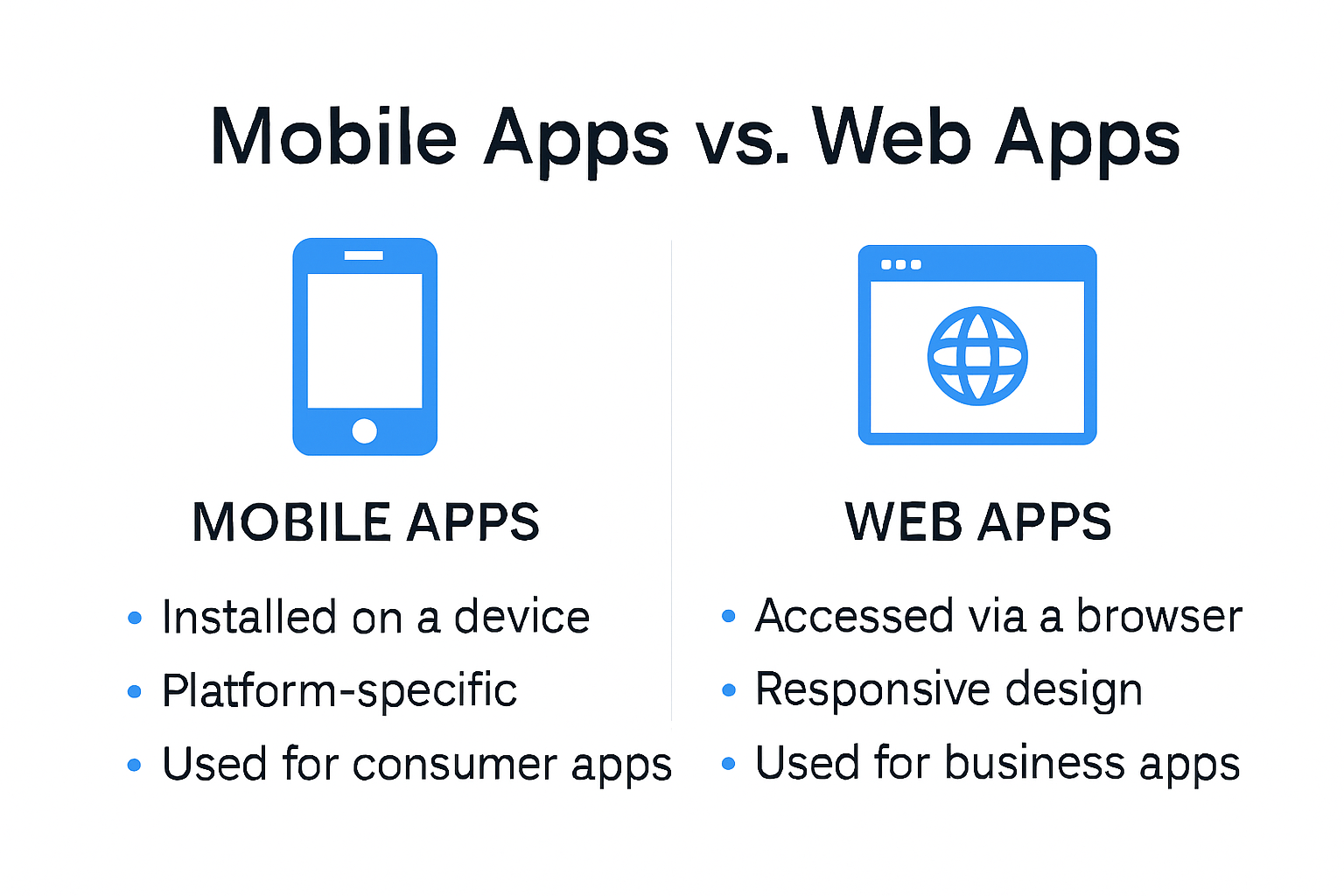Choosing between mobile apps and web apps can feel overwhelming for any business, especially as both seem to offer everything you need. But while it sounds logical to just build one and move on, the numbers paint a different picture. Native mobile apps are shown to be up to 50 percent more energy efficient and deliver much smoother performance than their web-based counterparts. Yet most companies still overlook an even bigger shift happening right now. Hybrid solutions like Progressive Web Apps are rising fast, blending the best of both worlds and shaking up tech decisions for 2025.
Table of Contents
- Understanding Mobile Apps And Web Apps
- Key Differences: Features, Cost And Performance
- Which Solution Fits Your Business Needs?
- Future Trends: Mobile Apps Vs Web Apps In 2025
Quick Summary
| Takeaway | Explanation |
|---|---|
| Mobile Apps Offer Superior Performance | Native mobile apps provide enhanced performance and smoother user experiences, especially for graphics-intensive tasks, due to better integration with device hardware. |
| Web Apps Provide Cost-Effective Development | Web applications are generally more economical to develop and maintain, as they offer cross-platform compatibility without the need for separate codebases for iOS and Android. |
| Strategic Considerations Are Key | Businesses must assess their specific operational requirements, user demographics, and budget constraints when choosing between mobile and web applications, ensuring alignment with long-term digital strategies. |
| Hybrid Solutions Are Emerging | The convergence of technologies and the rise of Progressive Web Apps (PWAs) highlight the need for businesses to adopt hybrid approaches that combine the strengths of both mobile and web applications. |
| AI Integration Will Transform Applications | By 2025, integrating artificial intelligence into mobile and web apps will enable predictive functionalities, enhancing user experiences and automating complex tasks. |
Understanding Mobile Apps and Web Apps
The digital ecosystem of business applications has evolved dramatically, presenting organisations with critical strategic choices between mobile apps and web apps. While these technologies might seem similar on the surface, they represent fundamentally different approaches to delivering digital experiences and solving business challenges.

Core Technological Distinctions
Mobile apps and web apps differ significantly in their architectural design, performance characteristics, and user interaction models. Research from the National Institutes of Health reveals that technological usability and organisational requirements play pivotal roles in determining the most appropriate solution for specific business contexts.
A mobile app is a software application specifically developed to run on mobile devices like smartphones and tablets. These applications are typically downloaded from app stores such as Google Play or Apple’s App Store and are designed to leverage device-specific hardware and operating system features. They offer high performance, can function offline, and provide deep integration with device capabilities like GPS, camera, and push notifications.
In contrast, a web app is an internet-enabled application accessed through a web browser. These applications are responsive and can be used across multiple devices without requiring separate downloads. According to the Nielsen Norman Group, web apps provide greater flexibility and easier maintenance compared to native mobile applications.
To help distinguish the key characteristics of Mobile Apps and Web Apps, the following table summarises their main technological differences and typical use cases:
| Characteristic | Mobile Apps | Web Apps |
|---|---|---|
| Platform Dependency | Platform-specific (iOS/Android) | Platform-independent, runs in web browser |
| Installation | Downloaded from app stores | Accessed via browser, no installation required |
| Hardware Integration | Deep (GPS, Camera, Push Notifications) | Limited, browser-based |
| Offline Functionality | Robust, can work offline | Limited, often requires connection |
| Update Mechanism | User must update via app store | Instant updates, server-side |
| Use Case Example | Fitness tracker, mobile banking | Online shopping, dashboard analytics |
Business Implications and Selection Criteria
Choosing between mobile apps and web apps involves evaluating multiple strategic factors beyond pure technological considerations. Businesses must assess their specific requirements, target audience, budget constraints, and long-term digital strategy.
Key selection criteria include:
- Development Cost: Mobile apps typically require platform-specific development (iOS and Android), increasing initial investment. Web apps offer more cost-effective cross-platform compatibility.
- Performance: Mobile apps generally provide superior performance and smoother user experiences, especially for graphics-intensive or complex computational tasks.
- Update Mechanisms: Web apps can be updated instantly without user intervention, while mobile apps require users to download updates through app stores.
- Offline Functionality: Mobile apps excel in providing robust offline capabilities, crucial for scenarios with unreliable internet connectivity.
The decision is not about selecting a universally superior technology but finding the most appropriate solution aligned with specific business objectives. Technical capabilities must be balanced with user experience, development resources, and strategic goals.
Modern businesses increasingly recognise that the distinction between mobile and web apps is blurring. Hybrid approaches and progressive web applications are emerging, offering combinations of mobile app responsiveness and web app accessibility.
Ultimately, successful digital strategy requires a nuanced understanding of these technologies and their potential to transform business operations, customer engagement, and competitive positioning in an increasingly digital marketplace.
Key Differences: Features, Cost and Performance
Digital solutions demand precision in technological selection, where mobile apps and web apps present distinct advantages and challenges across features, cost, and performance metrics. Understanding these nuanced differences enables businesses to make strategic technological investments that align with their specific operational requirements.
Performance and Resource Utilisation
Research from the University of Technology reveals critical performance variations between mobile and web applications. Native mobile apps demonstrate significantly superior energy consumption and hardware resource management compared to web applications. This technical advantage translates into tangible benefits for users experiencing faster load times, smoother interactions, and more responsive interfaces.
Mobile apps leverage device-specific hardware capabilities more efficiently, enabling complex computational tasks with minimal latency. They can directly access smartphone components like GPS, accelerometer, and camera, providing seamless integrated experiences that web apps struggle to replicate. Such deep hardware integration allows for more sophisticated user interactions and advanced functionality.

Development Complexity and Cost Considerations
Comparative research on application development highlights substantial differences in development complexity and associated costs between mobile and web applications. Native mobile app development typically requires:
- Platform-Specific Programming: Separate codebases for iOS and Android
- Higher Initial Investment: More complex development processes
- Specialised Developer Skills: Advanced mobile development expertise
Web applications, conversely, offer more economical development pathways. They provide cross-platform compatibility, reduced maintenance overhead, and faster deployment cycles. Progressive Web Apps (PWAs) represent an emerging hybrid solution, bridging performance capabilities with development efficiency.
The following table compares Mobile Apps, Web Apps, and Progressive Web Apps (PWAs) across major factors of performance, cost, and user experience for a clearer overview:
| Factor | Mobile Apps | Web Apps | Progressive Web Apps (PWAs) |
|---|---|---|---|
| Development Cost | High (platform-specific) | Low (cross-platform) | Medium (single codebase) |
| Performance | Superior, hardware optimised | Adequate, browser-limited | Near-native |
| Offline Functionality | Full | Limited | Partial to full |
| User Engagement | High (push notifications) | Lower | High (push, installable) |
| Updates | User/app store | Instantly, server-side | Instantly, server-side |
| Device Integration | Deep | Limited | Moderate |
User Experience and Engagement Metrics
User experience represents a critical differentiator between mobile and web applications. Mobile apps generally deliver more immersive, personalised experiences through:
- Offline Functionality: Enhanced accessibility without constant internet connectivity
- Push Notification Capabilities: Direct user engagement mechanisms
- Intuitive Interface Design: Platform-specific interaction guidelines
Web applications excel in universal accessibility, offering instant updates and broader device compatibility. They eliminate installation barriers and provide immediate access through web browsers. However, they often compromise on performance and deep device integration.
Businesses must evaluate their specific requirements, target audience preferences, and technological ecosystem when selecting between mobile and web applications. The optimal solution depends on balancing performance needs, budget constraints, and strategic digital transformation objectives.
As technological boundaries continue evolving, hybrid approaches like Progressive Web Apps are emerging, promising to reconcile the strengths of both mobile and web application paradigms. Strategic technology selection demands continuous learning and adaptability in an increasingly complex digital landscape.
Which Solution Fits Your Business Needs?
Selecting the right digital solution requires a strategic approach that transcends simple technological preferences. Businesses must carefully evaluate their unique operational requirements, user expectations, and long-term digital transformation objectives when choosing between mobile apps and web apps.
Strategic Decision-Making Framework
According to the Forbes Technology Council, understanding user behavior and aligning technological choices with business goals is paramount. This decision-making process involves comprehensive analysis of multiple critical factors that extend beyond surface-level technological capabilities.
Key strategic considerations include:
- Target Audience Characteristics: User demographics, device preferences, and technological literacy
- Functional Requirements: Specific features and performance expectations
- Budget Constraints: Initial development and long-term maintenance costs
- Technical Infrastructure: Existing technological ecosystem and integration capabilities
Performance and User Experience Alignment
Research from Michigan Labs highlights that mobile apps offer superior performance and responsiveness, particularly when accessing device-specific features like GPS, camera, and push notifications. This technological advantage becomes crucial for businesses requiring sophisticated user interactions and seamless hardware integration.
Mobile Apps Recommended When:
- Requiring complex device-specific functionality
- Prioritising offline accessibility
- Needing high-performance computational tasks
- Targeting users with consistent smartphone usage
Web Apps Recommended When:
- Seeking broader device compatibility
- Minimising development and maintenance costs
- Requiring instant updates without user intervention
- Targeting diverse user bases with varied technological access
Future-Proofing Your Digital Strategy
Energy consumption research demonstrates that native mobile apps consume less energy and leverage hardware resources more efficiently. This technical insight suggests that businesses should consider not only immediate requirements but also long-term technological sustainability.
Progressive Web Apps (PWAs) represent an emerging hybrid solution, offering a balanced approach that combines web accessibility with mobile app-like performance. These applications provide businesses with flexibility, allowing gradual technological evolution without complete system overhauls.
Successful digital strategy demands continuous adaptation. The ideal solution is not a universal template but a customised approach tailored to specific business contexts. Companies must remain agile, regularly reassessing their technological choices as user behaviors, market dynamics, and technological capabilities evolve.
Ultimately, the choice between mobile and web apps is not about selecting a superior technology but finding the most appropriate digital solution that enhances operational efficiency, user engagement, and competitive positioning. Businesses that approach this decision strategically will be better positioned to leverage digital technologies effectively and drive meaningful transformation.
Future Trends: Mobile Apps vs Web Apps in 2025
The digital technology landscape is rapidly transforming, with mobile and web applications at the forefront of innovation. As we approach 2025, emerging technological trends are reshaping how businesses conceptualise, develop, and deploy digital solutions.
Convergence of Technologies
Research from Armia reveals that Progressive Web Apps (PWAs) are bridging the traditional gap between mobile and web applications. These hybrid solutions offer an unprecedented blend of web accessibility and mobile app functionality, enabling businesses to create more versatile and responsive digital experiences.
PWAs represent a significant technological evolution, providing:
- Seamless Cross-Platform Performance: Consistent user experience across devices
- Reduced Development Complexity: Single codebase for multiple platforms
- Enhanced Offline Capabilities: Functionality without constant internet connectivity
Artificial Intelligence Integration
According to WillowTree’s research, artificial intelligence will fundamentally transform both mobile and web applications by 2025. AI-powered apps will transition from reactive to predictive systems, anticipating user needs and automating complex tasks before users consciously recognise requirements.
Key AI-driven application capabilities will include:
- Predictive User Behaviour Analysis: Personalised experiences based on individual interaction patterns
- Automated Task Completion: Intelligent background processes reducing manual interventions
- Contextual Recommendations: Proactive suggestions tailored to individual user contexts
Energy Efficiency and Performance Optimization
Energy consumption research indicates that future applications will prioritise resource efficiency. Native mobile applications are expected to become increasingly sophisticated in managing hardware resources, offering superior performance while minimising energy consumption.
Emerging technological trends suggest that successful digital solutions in 2025 will:
- Prioritise User Experience: Seamless, intuitive interactions across platforms
- Embrace Technological Flexibility: Adaptable architectures supporting rapid innovation
- Integrate Advanced Technologies: Artificial intelligence, machine learning, and edge computing
Businesses must recognise that the future of digital applications is not about choosing between mobile and web platforms but creating integrated, intelligent ecosystems that transcend traditional technological boundaries. The most successful organisations will be those capable of leveraging hybrid technologies, understanding user needs, and rapidly adapting to evolving digital landscapes.
As technological boundaries continue dissolving, the distinction between mobile and web apps will become increasingly blurred. Organisations that embrace this complexity and view digital solutions as dynamic, interconnected systems will be best positioned to drive meaningful digital transformation and maintain competitive advantage.
Frequently Asked Questions
What are the main differences between mobile apps and web apps?
Mobile apps are downloaded and installed on devices, offering superior performance and offline functionality. Web apps run in browsers, providing cross-platform compatibility but often with limited hardware integration.
Which type of app is more cost-effective to develop?
Web apps are generally more economical to develop as they require a single codebase for multiple platforms, while mobile apps often necessitate separate development for iOS and Android.
When should I choose a mobile app over a web app?
Choose a mobile app if you need high-performance features, offline access, and deep device integration, particularly for tasks like gaming or navigation that require intensive resources.
What are Progressive Web Apps (PWAs) and why are they gaining popularity?
Progressive Web Apps combine the best features of both mobile and web apps, offering offline capabilities and improved performance while being accessible through a web browser. Their flexibility makes them an attractive option for businesses in 2025.
Take the Uncertainty Out of Choosing Your Next App Solution
Struggling to decide between mobile apps or web apps for your business in 2025? This article highlighted the core challenge: finding a digital solution that delivers high performance without breaking the budget. Many leaders feel the pressure to make the right investment, not just for today but to keep their brand future-proof against rising trends like Progressive Web Apps, advanced AI features, and platform-specific demands. If you have been worrying about how to blend user experience, cost effectiveness, and long-term scalability, you are not alone.
Gain peace of mind by partnering with a team that understands every nuance discussed here. At Cloudfusion, we consider your unique business requirements and recommend custom solutions that align with your goals. Whether you require a fully bespoke mobile app, a powerful web application, or a progressive approach that combines both, our experts turn strategy into reality. Ready to future-proof your online presence? Request a free web design and development quotation today at this page and start building your competitive advantage now. Let Cloudfusion move your business forward with tailored innovation.








